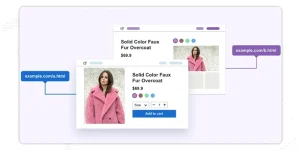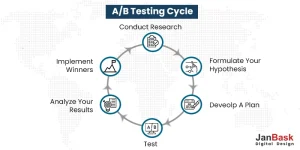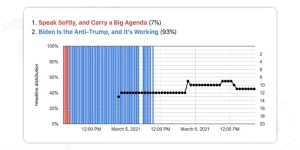
Have you ever felt like Goldilocks, trying to find the perfect fit for your website or marketing campaign? Maybe you tried a button color that was too cold, a layout that was too hot, or a headline that was just right. The good news is that A/B testing can help you find the sweet spot and optimize your content for maximum success.
In this AB testing guide, we'll take a closer look at what is A/B testing, what are its examples, why it's important, and how a digital marketing agency can use it to improve your website or marketing campaign. So grab a bowl of porridge, and let's dive in!
Here we go:

Implement A/B Testing for Success?
AB testing is also known as split testing or bucket testing. It is a statistical technique or method used in marketing and website optimization to compare two versions of a webpage or email campaign to determine which is more effective in achieving the desired goal, such as increasing sales, sign-ups, or engagement.

This method involves randomly splitting a sample of users into two groups and exposing each group to a different version of a webpage or email and then analysing the data to determine which version performs better.
A/B testing may seem daunting, but in reality, it utilizes a familiar methodology that many of us already use in our daily lives for various purposes. This method involves creating two versions of an asset, such as a website, button, advertisement, or offer, which are then displayed to users online in a random manner to ensure accurate results.
So, what is AB testing? In essence, A/B testing allows for evaluating the effectiveness of a new version of the original asset, with the original asset serving as the control group and the new version as the experimental group. Depending on the goals of the test, either the original version or the new version is displayed to users, and the one that performs better is ultimately retained.
Alternatively, some opt for multivariate testing, which involves modifying multiple elements of the original asset. However, this approach can be somewhat challenging as isolating which element led to the results can be difficult.
For instance, suppose a website owner has been using a call to action button example with the copy "Download Now" for some time and wants to test a new version before implementing the change. In this scenario, the owner can perform A/B testing by creating a new version of the CTA button with the copy "Download My Free Guide Now." Both versions of the button are then randomly displayed to users, and the one that leads to more conversions is selected.
By utilizing A/B testing or multivariate testing, businesses can make data-driven decisions and optimize their assets to maximize performance and achieve their goals.
A/B testing has been shown to be a highly effective tool for businesses and marketers. In fact, according to a survey by Consultancy, 71% of businesses said that they use A/B testing to improve their conversion rates. Another study found that A/B testing can increase website conversion rates by an average of 20%.
One famous example of successful A/B testing comes from Barack Obama's presidential campaign in 2008. The campaign tested different versions of its website to determine which version generated more donations. By changing the call-to-action button from "learn more" to "donate now," the campaign was able to increase donations by 11.6%.
Now that you’ve seen what is AB testing and how it works, let’s explore the different types of A/B testing.
Several different types of A/B testing can be used depending on the specific goals of the test. In this particular section of the AB testing guide, we'll explore some of the most common types of A/B testing, along with their relevant case studies.

Split testing, also known as A/B testing, involves comparing two versions of a webpage or campaign to determine which one performs better. This is the most common type of A/B testing and can be used for a wide variety of goals, such as improving click-through rates, increasing conversions, or reducing bounce rates.

Multivariate testing involves testing multiple variations of different elements on a webpage or campaign to determine which combination performs the best. This type of testing is useful for identifying the optimal combination of elements such as headlines, images, and calls to action.
Visual Website Optimizer, an A/B testing software company, used multivariate testing to optimize the homepage of their website. They tested 24 different combinations of headlines, images, and calls to action and found that combining a specific headline and call to action resulted in a 72% increase in sign-ups.
Sequential testing involves testing multiple variations of a webpage or campaign in a specific order to determine which one performs the best. This type of testing is useful when multiple changes need to be made to a webpage or campaign, and it is not feasible to test all variations simultaneously.
Amazon used sequential testing to optimize the checkout process on its website. They made a series of changes to the checkout process over several months and tracked the results of each change. By using sequential testing, they were able to identify the optimal combination of changes that resulted in a 15% increase in conversions.
Bandit testing, also known as multi-armed bandit testing, is a type of A/B testing that dynamically allocates traffic to different webpage variations or campaigns based on their performance. This type of testing is useful when there are a large number of variations to test, and it is not feasible to test them all equally.
Etsy, an online marketplace for handmade and vintage goods, used bandit testing to optimize their search results page. They tested over 8,000 combinations of search results and dynamically allocated traffic based on which combinations performed best. This resulted in a 5.5% increase in search result clicks.
A/B testing for UX is a powerful tool businesses can use to optimize their digital assets and achieve their goals. In this section of our AB test guide, we will delve into the reasons why this technique is so essential. So, let's explore the topic further and discover the key factors that make A/B testing a vital tool for modern businesses.
A/B testing is a powerful tool for improving the performance of websites and marketing campaigns, ultimately increasing your online sales. However, planning an A/B test can be daunting; without proper planning, it can lead to inaccurate results and wasted time and resources. So let’s go over the key steps to planning a successful A/B testing now. Here we go:

The first step in planning an A/B test is to define your hypothesis. What specific change do you want to test, and what outcome do you expect? For example, you might hypothesize that changing the colour of a call-to-action button will increase the click-through rate on a landing page. Defining your hypothesis upfront helps you focus your test and ensures that you measure the right variables.
The second step is identifying the variables you want to test. As mentioned earlier, it's important to change only one variable at a time to ensure that you can identify which version is responsible for any changes in user behavior. Some common variables to test include headlines, images, copy, layout, and calls to action.
The third step is choosing the metrics you want to track. What data will you use to determine which version performs better? Some common metrics to track include click-through rates, increased conversion rates for small business websites, time spent on the page, and bounce rates. Choose metrics that are relevant to your hypothesis and goals.
The fourth step is determining your sample size. How many users do you need to show each version to in order to achieve statistically significant results? Several online calculators and statistical tools are available to help you determine your sample size. Make sure your sample size is large enough to generate reliable results.
The final step in the AB test guide is setting up your test. Use A/B testing software or tools like Google Optimize to create and deploy your two versions. Ensure your test is set up correctly and your traffic is evenly split between the two versions.
Analysing A/B test results is important because it allows businesses to make data-driven decisions and optimize their website or marketing campaigns for better performance. In this A/B testing tutorial, we’ll be listing some ways you can analyse A/B test results:
As technology continues to evolve, the importance of having a website that performs at its best cannot be overstated. A website is often the first point of contact between a business and potential customers. It is, therefore, crucial to have a website that is user-friendly and optimized for conversion. One of the most effective ways of improving website performance is through A/B testing. So now, in this A/B testing tutorial, we will look at a few A/B testing examples that can help improve your website's performance.
CTA buttons are crucial elements of a website as they guide visitors toward the desired action. A/B testing can help determine the best color for the CTA buttons. Performable conducted A/B testing on its website by randomly displaying its CTA button in two different colors, green and red. This simple change had a significant impact on the overall conversion rate of the page. Surprisingly, the red CTA button outperformed the green button by a whopping 21%.
The headline is often the first thing that visitors see on a website. A/B testing different headline text can help determine which headline performs best in terms of engagement and conversion.
New York Times once performed A/B testing on its digital headline. As planned some readers saw one headline and the rest saw an alternative headline for a particular duration. Finally, whichever headline attracted more readers was retained.
The original headline, "Speak Softly, and Carry a Big Agenda," which alluded to President Biden's governing style, received only a 7% readership rate. In contrast, the alternative headline, "Biden Is the Anti-Trump, and It’s Working," proved much more effective, capturing the attention of an impressive 93% of readers.
Lead forms are critical components of a website as they help businesses capture contact information from potential customers. Testing different positions for lead forms can help determine which position leads to the high-impact conversion rate optimization. For example, a test conducted by Mos showed that moving the lead form from the sidebar to the body of the page increased conversions by 71%.
A/B testing has become a popular and powerful tool for businesses looking to improve their conversion rates and achieve their goals. By testing variations of a webpage or marketing campaign, businesses can gain valuable insights into what works best for their audience and optimize their strategies accordingly. However, A/B testing is not without its challenges, and it's important for businesses to approach it with a clear understanding of the process and potential pitfalls. If in doubt, hire a professional A/B testing agency. In this section, we'll explore some common mistakes businesses make when conducting A/B testing and how to avoid them to get the most accurate and useful results.
1. What is A/B testing, and how can it benefit my business?
A/B testing compares two versions of a webpage, email, or advertisement to determine which version performs better in terms of engagement or conversion rates. A/B testing can benefit your business by providing insights into what elements of your website or marketing campaigns are most effective and how to optimize them for maximum impact.
2. What elements of my website or marketing campaigns should I test?
Many elements of your website or marketing campaigns can be tested, including headlines, images, call-to-action buttons, page layout, and even the colors used on your website. The key is to identify the elements that are most likely to have an impact on engagement or conversion rates and prioritize testing those first.
3. How long does A/B testing typically take?
The length of an A/B testing campaign can vary depending on the complexity of the elements being tested and the amount of traffic to the website or marketing campaign. In general, running A/B tests for at least two weeks is recommended to ensure sufficient data is collected to make informed decisions.
4. How much does A/B testing cost?
The cost of A/B testing services can vary depending on the complexity of the testing being performed and the expertise of the testing team. Some A/B testing platforms offer self-service plans that can be relatively affordable, while more advanced services may require a larger investment. Evaluating the potential return on investment is important when considering the cost of A/B testing services.
5. How do I know if an A/B testing campaign is successful?
An improvement in engagement or conversion rates typically measures success in A/B testing. It is important to establish clear goals and metrics for success at the outset of the campaign and monitor the results closely throughout the testing process. A/B testing can help businesses identify what is working and what isn't, providing insights to make informed decisions and continually improve the website and marketing performance.
A/B testing is a powerful tool that can unlock the full potential of your website. By testing and optimizing various elements such as headlines, images, call-to-action buttons, and page layout, you can improve the user experience, increase engagement, and drive conversions. But A/B testing is not just about making changes for the sake of change. It's about making data-driven decisions to ensure you give your users the best possible experience.
By embracing A/B testing, you can gain valuable insights into what works and what doesn't. You can test hypotheses and ideas and use the results to make informed decisions that drive business success. With the right testing strategy, you can continually improve your website's performance, ultimately boosting conversions and revenue.
As with any data-driven decision-making process, A/B testing requires ongoing analysis, monitoring, and adaptation. But with the right A/B testing agency, you can harness the power of data to optimize your website for success. So start experimenting, testing, and refining your website today - your users (and your bottom line) will thank you for it!
Are you planning for A/B Testing?

M
The real-life examples of A/B tests in action are fantastic.
O
A/B testing is an absolute game-changer for improving website performance and conversion rates.
C
Your blog offers valuable insights into A/B testing, making it a helpful resource for both beginners and experienced marketers.
C
A/B testing is an invaluable tool in the marketer’s arsenal.
A
This blog is your comprehensive guide to understanding, conducting, and leveraging A/B tests for success.